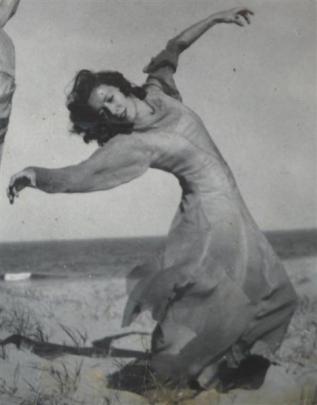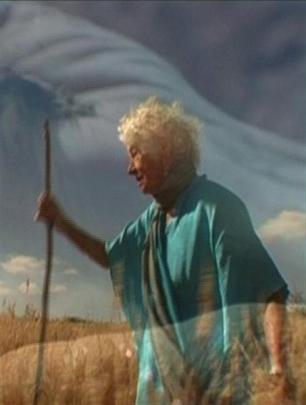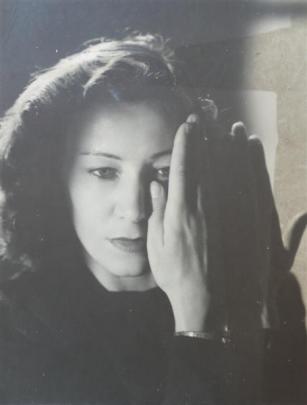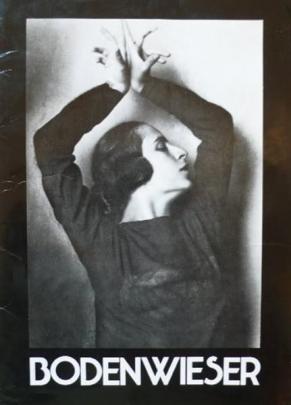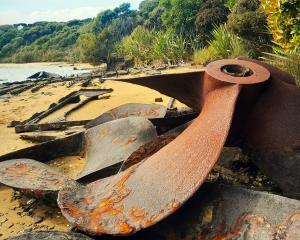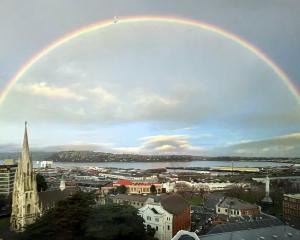Being invited to Vienna last year to tell the Viennese what their life was like in the 1930s seemed extraordinary for someone from Dunedin, but Shona Dunlop MacTavish leapt at it, as she has leapt at opportunities all through her life.
The Dunedin dancer and choreographer, now in her late 80s, is the last of the Viennese-trained pupils of the innovative modern dancer Gertrude Bodenwieser, who was associated with Ausdruckstanz, or German expressive dance, between the two world wars.
Shona Dunlop MacTavish's remarkable life has been blown by the winds of political events - in a Europe about to be overrun by Hitler, touring Colombia, South America, with the Bodenwieser Company in 1938, escaping Mao's army in China with her missionary husband, then living in South Africa as apartheid approached, before tragically returning home to Dunedin as a young widow with three small children.
The way dance has shaped her life and her life has shaped her dance is the subject of a new film, Wind Dancer, by Dunedin filmmakers Prof Lloyd Davies and Wiebke Hendry, of the Centre of Science Communication at Otago University, which will premiere at the Regent Theatre next Saturday.
"Shona's the mother of modern dance in New Zealand and one of Dunedin's treasures," says Ms Hendry.
"She's part of the cultural heritage of New Zealand and she's larger than life - the sparkle and character she has now is more than some 20-year-olds."
The young Shona Dunlop grew up in Dunedin but after the death of her father, Presbyterian theologian Prof Frank Dunlop, her mother Maude Dunlop took her and her brother Bonar to Europe in 1935 so Bonar could study art.
At barely 15, the young Shona became a pupil of the renowned Madame Bodenwieser (1890-1959), one of the leading exponents of German expressive dance.
The style had burst out in Germany and Austria in the 1920s at the same time figures such as composers Igor Stravinsky and Paul Hindemith and psychiatrist Sigmund Freud were making their mark, Mrs MacTavish says.
"It was a wonderful period between the wars. It was as if everybody had suddenly exploded out of the horror of the first world war and then in the middle of it all Hitler walks in and wipes it out.
"I think they are still angry. People say this was Austria at its best and want to try to rediscover their `lost years'."
That was the aim of the festival, Touchings: Dance before 1938 - Dance of Today, in Vienna last October, where Mrs MacTavish gave a class to demonstrate Bodenwieser's teaching methods, as well as a lecture on her work.
The class was attended by 60 young dancers from Vienna University and observed by several international dance critics, one of whom, Jacqueline Weiss from the UK, is coming to Dunedin this year to study Bodenwieser's methods with Mrs MacTavish.
"I suddenly got back my Viennese German, much to the dancers' amusement, because some of the words are a bit out of date by now.
"I was able to explain why Bodenwieser used the body in quite a different way from the way they use their bodies today," she says.
At the Vienna festival, one of Bodenwieser's dance dramas, "Terror" from Mask of Lucifer, a premonition of Hitler's invasion, had been re-created from Laban notation, the equivalent of a musical score that records the sequence of movement.
Mrs MacTavish was invited to the dress rehearsal but said she felt that although they had re-created the movements, the meaning had eluded them.
"What they lacked was the complete sense of that work and it was very hard for me to have to say that.
"They were so excited to have found that and to have resurrected it and yet I felt disturbed for this very reason that the dance from here on has retained its anger without its conception, as if it had taken the facade of the work without its centre being and that upset me."
Movement has to come from somewhere, she explains.
In expressive dance, which expresses emotion, it comes from deep within, from the solar plexus and flows with the breath through the body and, to be believable, always has to go a little further.
Even recently, while being filmed walking along the beach at St Clair, she felt she had to dance - it's not just physical movement, it's the freedom of the spirit, she says"I'm not walking sedately along the beach with the sea breaking at my feet and the wind blowing in my hair - I'm going to dance it.
"Sometimes I rather embarrass myself - this old lady, what's she doing leaping around the place - but it's an instinctive thing and it's come all through my life because I've absorbed so many cultures and drunk deeply of them."
That kind of freedom was not immediately observable in the crowded urban environment of central Europe.
"There are too many people on the streets. They don't know what it is like to leap across the beach, like yesterday when I couldn't bear to walk sedately. They don't understand that feeling of wanting to go with it."
During her class in Vienna, she asked the pupils to improvise a caged bird finding its freedom, expecting them to leap with joy but to her surprise, they didn't even leave the ground.
"I felt somehow it could be said this was indicative of the freedom they'd lost under Hitler, or the freedom they've lost through overcrowding of the great cities.
There isn't the liberation in their dance that I feel in modern dance I see in New Zealand.
We are able to eat space, which they seem to have lost in the big towns.
It's really interesting to me because it shows our responses to where we live and what we look at," she said.
When Hitler invaded Austria in 1938, Bodenwieser, a Jew, escaped and took her company on a tour of Colombia after which, with the help of the young Shona and her family, she settled in Australia.
She might otherwise have gone to America as many other refugees did, Mrs MacTavish says.
After working with Bodenwieser in Sydney for nine years and becoming her principal dancer, Shona Dunlop married Donald MacTavish, a young Canadian minister, and thought she would have to leave her dancing life behind for her new missionary life in Manchuria.
However, dance went with her, and she found dance wherever she went.
Even teaching Bible class in South Africa, where her husband was chaplain at Lovedale Missionary Institute, a educational institution unusual for its time because there was no racial segregation, she found her pupils responded to movement better than to words.
"I said, `Maria, how do you think Magdalena would have felt when Christ behaved so wonderfully to her?' and I said to a boy, `you show me the strength of Samson'.
And suddenly their bodies became articulate and the movement said more to them than my words could ever have done.
They are such physical people, and it just meant more to them to see the body respond to an idea or a thought than to be told this is what we think is so and so. I couldn't dictate, I had too much to learn from them."
Despite being missionaries, they were not there to proselytise, she says.
"We were much more interested in learning what their religion was, and what they did, and as we did that we began to see what the missionaries, despite the critics, had accomplished.
"They were largely responsible for the loosening of the bound feet in China; they established medical hospitals, orphanages, leper colonies; it was the missionaries who impressed on the Chinese that they could do better, that this was a way of life they must learn to do something about.
"What actually came out of that knowledge was I became very interested in things like apartheid, and social issues of that sort.
"So when I returned to New Zealand and started my Dunedin Dance Theatre, these were the themes I immediately grasped - exile, people coming to a new land and feeling absolutely lost. So all my ballets have social concerns.
I was still associated with church and Christianity but in a much more active way - a physical way because I'm a physical person. That was the only way I could say and speak my feelings about them."
Mrs MacTavish, who was awarded an MBE in 1985 and, in 2002, an honorary doctorate by the University of Otago, still teaches a weekly class in Dunedin with the help of another former pupil, Suzanne Renner from the University of Otago College of Education.
Some of her students have been with her for more than 30 years, she says.
Although styles of dance necessarily change and develop, Mrs MacTavish's work has always continued Bodenwieser's insistence that dance have meaning and relevance.
It's something she passed on to her former pupils who have made careers in dance, such as Carol Brown, Michael Parmenter, Jan Bolwell, and Bronwyn Judge, who accompanied her to Vienna to demonstrate at her class.
Before anything really creative can happen you have to have a vision, she says. Her works have dealt with freedom, apartheid and homosexuality.
When teaching in the Philippines for 18 months in the 1970s, she created an anti-nuclear war ballet, Requiem for the Living, which sparked a petition against the proposed nuclear arsenals there.
But dance should cover all aspects of life, she says. "We are not always angry at people. We do have to stand up to injustices, but let us sometimes just look at the beauty of nature and allow that to be a force in our lives and things we do creatively."
According to Ms Hendry, throughout her work, Shona Dunlop MacTavish's love for humanity and tolerance for different places and cultures stands out above everything.
"Shona had an empathy with these cultures and the way they used things like dance. She has always had her own interpretation of Christianity and has always seen the possibilities rather than the limitations of it, and I think that really makes the difference," she says.

